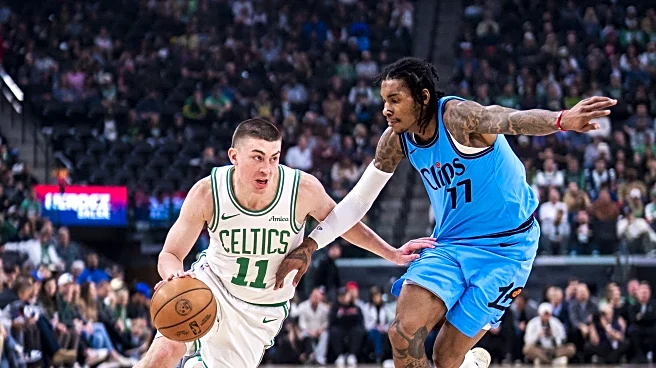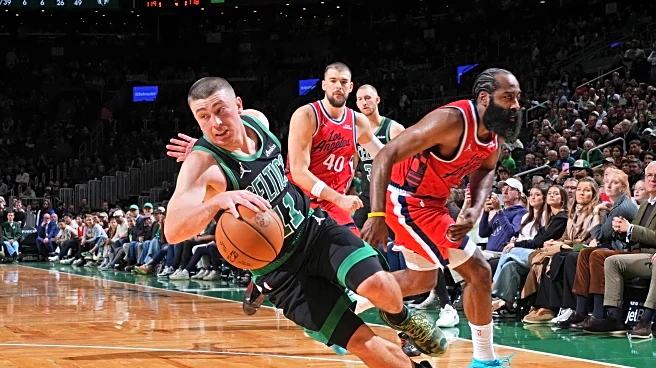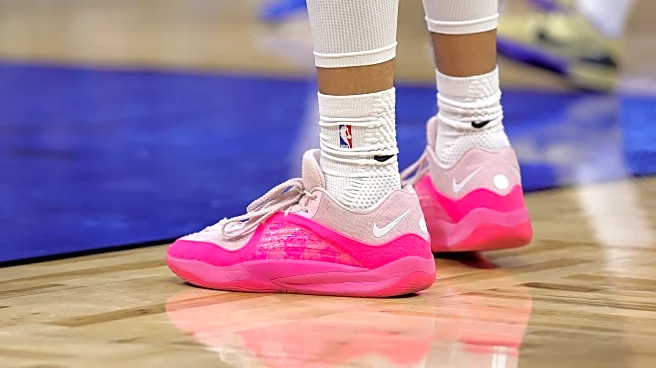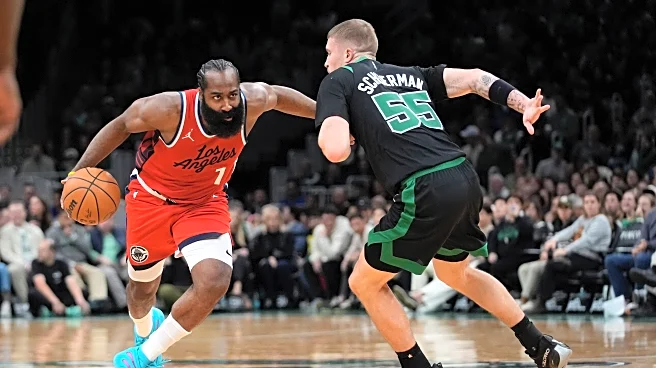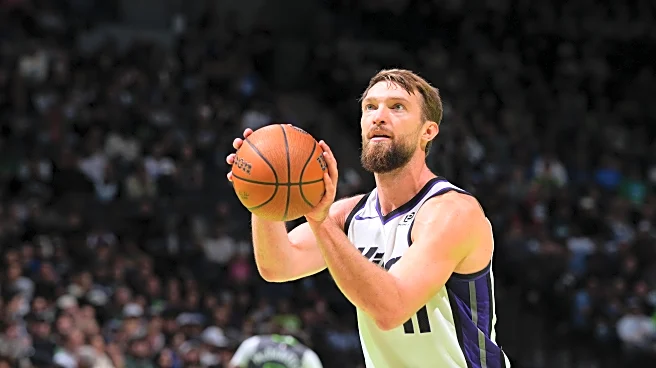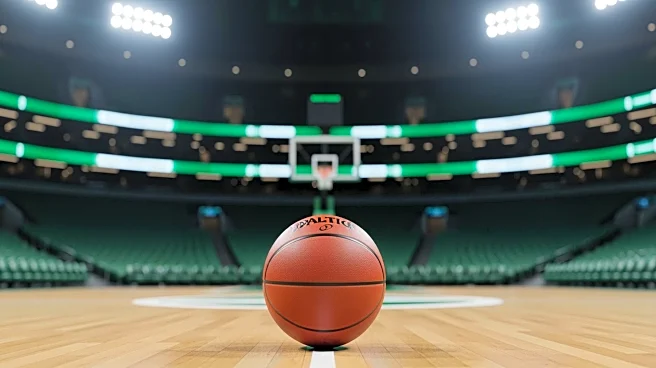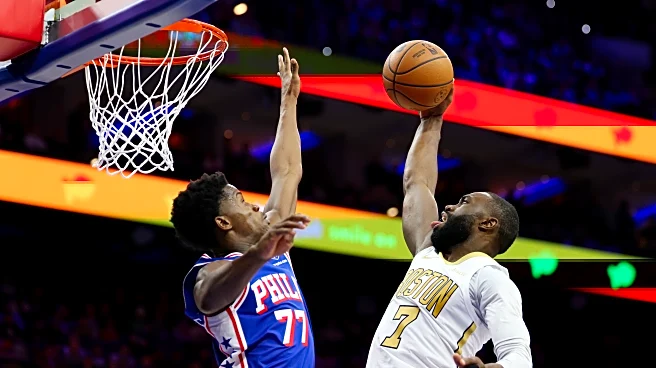The Celtics got back to .500 with a narrow 121-118 win vs. James Harden and the Los Angeles Clippers. The return of marksman level shooting from Payton Pritchard and Derrick White certainly aided the Celtics beating
their season average of 113.8 points per game, but I also thought they ran some nice sets to get their guys in position.
Several sequences stood out to me, showcasing how effectively Boston created quality looks. These next few sets illustrate how Boston’s spacing, timing, and decision-making opened the floor
Here the Celtics use “Horns Chest” to get into “Turn Zoom” action on their first possession.
This play starts off in “Horns” alignment. The quickest way to identify that is two players at the elbow of the free throw line like White and Neemias Queta are. The handler will also be at the top of the key with both corners filled. This is like a 1-2-2 formation and resembles the shape of a bull’s horns.


Based on the speed of the offense and/or how they like to run the play, the players won’t be positioned exactly at the elbows as you can see White is slightly above, but you’ll be able to tell that it’s still Horns.
The “Chest” part is an action the Celtics have run a ton this season, and it’s when a player sets an on-ball screen then receives a Flare screen. The on-ball screen can be a regular screen or a ghost screen. Below is an example of the Celtics running Horns Chest to get Jaylen Brown a three.
Chest actions also can happen at any time, not just out of Horns alignment. Here Joe Mazzulla calls it on a SLOB (sideline out of bounds) play.
Since the Celtics have run this mostly to score this season, I thought it was smart that they used it to get into another action. After the Chest action, both White and Queta run towards Jordan Walsh in the corner. Queta then receives the ball initiating the Turn Zoom. Zoom action (also called Chicago) is a pin down or off ball screen into a dribble handoff.

This particular play is called Turn Zoom because as you see Walsh literally turns into the off-ball screen. He gets just enough of White’s defender which allows White to keep the defender behind him on his way to a floater. Keep in mind on this play that Ivica Zubac is in drop coverage.
Next, the Celtics run the same play just not directly out of Horns alignment.
White sets the Ghost screen, Queta sets the Flare, then receives the rock as White goes over to Walsh. Walsh turns again into the screen, and the Celtics get into the play, but this time the Clippers play it differently.
Last time, the Clippers had Zubac in drop coverage which allowed White to drive and get a floater. This time Zubac hedges, not allowing White to easily turn the corner. Hedge = when the screener’s defender steps out on the handler to ideally stop the handler’s progress and allow his teammate to get back to the ball.
This puts two defenders on the ball for just a split second, which means a two-on-one is created.

John Collins, who was guarding Walsh, now has to “tag” and stop Queta from rolling wide open to the basket. As he does that, it leaves Walsh open from three. Walsh doesn’t make them pay this time, but he’s been shooting 41% from behind the arc over his last 7 games.
Here we have the Celtics giving Pritchard the option of two ball screens, and it creates a two-on-one.
This play starts with a Zipper cut. Zipper cut is when a player receives a pin down screen at the block and cuts through to the top as Pritchard does on the play.

The timing on this play by the screeners was really impressive. Before Pritchard fully turns around with the ball, Luka Garza is running up to set the screen. Even more impressive is Josh Minott. He’s going to purposefully run into Brook Lopez, allowing Garza to screen freely. Pritchard rejects the Garza screen with a spin move that negates the Lopez hedge on that side. Him doing this now forces Harden to him, creating the two-on-one.

Garza rolling takes Lopez with him in the paint as Lopez holds his hand to stay attached (aww) which leaves Minott completely open to catch and drive. Minott makes a nice play and hits Garza for the layup
The Celtics went back to Turn Zoom here, and it gets White an open three.
On this one, you can really see the benefits of turning into the screen. Jordan Miller (#22) tries to feel where Minott is, and it looks like once he feels him go past, he isn’t expecting anything. Nic Batum also sniffs out this play late, which gives White all the space he needs.
This play sees the Celtics running more Chest action, leading to an open lane for White.
Walsh and Queta set screens for White to get to the top then everything starts. Pritchard sets the ghost screen and runs into the Flare by Queta. This can be simplified as Ghost Flare. The play creates two key advantages for White. First, Queta being all the way at the three-point line brings Zubac with him and out of the paint. Second, Pritchard’s ghost screen momentarily freezes White’s defender, just long enough for White to blow by and get downhill.
Next, the Celtics go to “Flex” Action which leads to a Graza three.
Flex action is a type of screen-the-screener action that involves a player setting a Flex screen then receiving a pin down. A flex screen is when someone sets an off-ball screen for someone in the corner or short corner for them to cut into the paint. The player receiving the screen can either cut across the paint or baseline cut.


Depending on who the main option is, the flex screener will elect to cut the screen short and just race to the pin down. The play below is an example of the Celtics using it to get JB post up position.
Steph Curry would of course be the top option for the Warriors, so he just runs to the pin down.
Here the Celtics get it to Baylor Scheierman and a good pin down by Garza gets him free to drive. He drives at Zubac with Harden trailing which leaves the Garza pop open.
Brown and Queta run a simple spread pick and roll, but Queta makes a nice play ensuring the finish for his teammate.
After setting the on-ball screen, Queta sets a “Gortat” screen that keeps Lopez from challenging Brown. A Gortat screen is when the screener seals or obstructs the opposing big while a handler is driving. It’s usually used to combat drop coverage.
Former Celtic Daniel Theis used to do this a lot and sometimes got foul calls for it. Here Queta does a nice job stopping Lopez from getting to Brown.
Lastly, the Celtics go to Spain Pick and roll.
Spain PnR of course is a pick and roll in which there is a back screen on the ball screeners man. Because Lopez is playing above the three-point line, Brown doesn’t have to screen. White continues to dribble towards Lopez and waits for his defender to get back to him, which gets Queta free. He finishes well.


